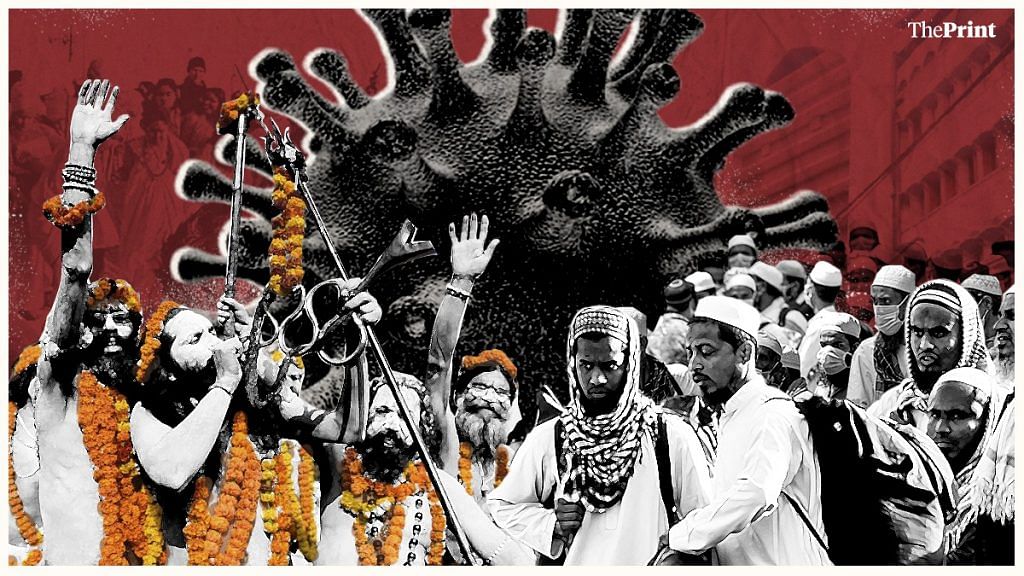There’s nothing more liberating than the truth. And currently, India’s truth is that when a minority community practises their religion, particularly in the time of Covid, it is seen as malicious.
Muslims were labeled jihadis and super spreaders at the beginning of the coronavirus pandemic in India last year in March when over 3,000 of them, including foreign nationals who had visas and permission by the government of India to attend the Tablighi Jamaat, congregated at the Markaz in Delhi’s Nizamuddin.
Another example is that of the Sikhs hoisting the ‘Nishan Saheb’ flag at the Red Fort on 26 January this year as part of the farmers’ protests. Though this act by a select group of protesters was illegal, they were immediately branded as ‘Khalistani terrorists’ for wanting to divide India so that they could carve out their own country for the Sikhs.
Then there are Christians who have been attacked and called “rice bags” for allegedly forcing poor Hindus and tribals to adopt Christianity through their missionary work. According to Persecution Relief, an organisation that aims to protect the right to worship guaranteed by the Constitution, crimes against Christians rose by 40.87 per cent during the lockdown.
And now during the second wave of the pandemic, when the cases are rising faster than inflation, we are witnessing the Maha Kumbh in its full glory after 11 years.
Also read: Why mosques in rear view mirror, like Kashi’s Gyanvapi, can crash India’s drive into future
The Maha Kumbh, covid’s maha opportunity
The Maha Kumbh was last held in 2010. And if in case you are awfully optimistic, it might be seen as a great break from the gloom and doom that the world is facing since the past one year — to have a congregation where lakhs of devotees will throng in good faith. But then if you happen to be pragmatic, you will also see one lakh forty-five thousand three hundred and eighty- four red flags because those are the highest single-day Covid cases that have been reported on Friday. And the numbers don’t seem to be going down anytime soon. We are in the vortex of the second wave.
But it isn’t just about the numbers. It is about the stark bias that is being seen in reporting in media as well as government approvals for such religious gatherings vis-à-vis the minorities. On Friday, a huge gathering of people at the Banke Bihari Temple in Mathura, where absolutely no Covid guidelines were followed, was allowed by the authorities. While the CMO of Mathura district insisted to ANI that all temples and dharamshalas were told to follow covid protocols, videos emerging from the temple tell a rather different story.
#Mathura | We have issued guidelines to all temple managment committees, dharamshalas, hotels to ensure people follow COVID19 protocols. We've deputed teams for collection of test samples and sanitisation at temples. There are 500 active cases in the district: Rachna Gupta, CMO pic.twitter.com/IPXQrcKB7K
— ANI UP (@ANINewsUP) April 9, 2021
Media persons, who had cried hoarse during the Tablighi Jamaat fiasco, appear to have lost their voices now. It seems as if only Muslims can spread the coronavirus and any other religious congregation is Covid-free despite glaring lapses in protocol.
Truth be told, it isn’t the observance of any religious practice that’s problematic. People know this is a pandemic and the dangers it poses. In spite of that, if they choose to break Covid protocol, it shows their insensitivity. The real problem lies in the selective punitive measures meted out to those who belong to the majority versus those from minority communities. While the Tablighi Jamat members were slapped with cases under the IPC, the Epidemic Diseases Act, the Disaster Management Act and even the NSA — at a time when India knew little about the imported virus, and all religious places functioned normally — now, after 1.7 lakh deaths, similar religious gatherings by other communities appear immune to any State action.
Also read: SC ‘disappointed’ with Centre’s affidavit defending media reporting of Tablighi event
Covid in mosques, faith in temples
The problem also lies in the unapologetic and unabashed differential treatment that is normalised by the media. Reporting of a mosque spilling with people is very different from reporting of a temple spilling with people. While both are wrong, one is shown as a matter of faith while the other as terrorism. This isn’t new but we must keep calling it out till we can.
The bigoted idea that Muslims seem to do no good is openly shown on our TV screens. Muslim aspirants of UPSC are being called jihadis trying to enter the bureaucracy and wage a ‘holy war. There has been no legal action against such peddlers of bigotry. When a French school teacher Samuel Paty was murdered by a man for showing his students the cartoon of Prophet Muhammad, most Muslims unequivocally condemned the barbaric act but also showed their displeasure with the offensive caricature. I too expressed my displeasure with the cartoons. But we ended up being called extremists for doing so. This in a country where a movie like ‘Padmavati’ can cause people to go up in arms for portraying a queen, who some treat as goddess. Amusingly, those vilifying Muslims for being intolerant over the cartoons (which they said was freedom of expression) were offended by M.F. Husain’s paintings of Hindu deities clothed in “nothing but the sky”. Hussain was sent death threats over these artworks and had to go into exile because of it.
There’s indeed nothing more liberating than the truth. And the truth is that India has the fangs of communalism deeply dug into it. It should liberate those who still question whether communalism is a small town parochial minded phenomena that shouldn’t matter much. It is now a pan-India urban phenomena that is changing the soul of our country.
The author is a political observer and writer. Views are personal.
Edited by Anurag Chaubey
